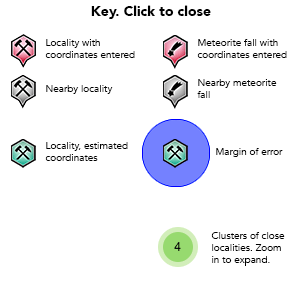Cambria Mine, Thames, Thames-Coromandel District, Waikato Region, North Island, New Zealand

| Latitude & Longitude (WGS84): | 37° 7' 34'' South , 175° 32' 33'' East |
|---|---|
| Latitude & Longitude (decimal): | -37.12629,175.54252 |
| GeoHash: | G#: rckuf965t |
| Köppen climate type: | Cfb : Temperate oceanic climate |
Historic gold mine. Located immediately south of the Non Pareil Mine, on the northern side of Waiotahi Stream.
The Cambria Gold Mining Company was formed in 1884 and soon found rich gold as a bonanza at 234-294 feet below the surface, accessed by the Cambria shaft. The bonanza was 20 feet below the No. 3 level, occurring where the reef intersected a cross-vein one foot wide, and clay filled fissure. The reef here carried rich ore 4-10 feet wide, with specimen stone within this 2-3 feet wide.
During a month in 1885, 5599 ounces of gold was recovered. 4160 ounces and 2574 ounces are mentioned as fortnightly results across late 1885 to early 1886. The Cambria Mine was the ninth largest producer on the goldfield at 59 151 ounces of gold from 30 915 tonnes of ore. The company is said to have lasted until 1897, when it was incorporated into other leases, but little information was found in the 1890's for it as a separate mine.
Peter Johnstone (52) was killed in the mine in 1888, although the reason is not mentioned. In 1898, John Cameron (58) committed suicide by throwing himself down the Cambria shaft.
The mine is mentioned briefly 1909 to 1914 as the New Cambria.
The Cambria Reef is sometimes called the Waiotahi-Cambria, reflecting it is the same reef but thrown by the major Moanataiari Fault which cuts the reef in half. The reef trends north-east to south-west, showing complex forking (anastromising?), and numerous blows of quartz. Economic ore was found confined to the Hanging Wall, with small auriferous quartz veins across the rest of the reef. Below the No. 4 level, gold grades rapidly diminished.
The quartz contained pyrite, crystallised stibnite, and ruby silver coloured pyrargyrite.
Mineral List
5 valid minerals.
Regional Geology
This geological map and associated information on rock units at or nearby to the coordinates given for this locality is based on relatively small scale geological maps provided by various national Geological Surveys. This does not necessarily represent the complete geology at this locality but it gives a background for the region in which it is found.
Click on geological units on the map for more information. Click here to view full-screen map on Macrostrat.org
| Miocene 5.333 - 23.03 Ma ID: 1308094 | Coromandel Group Miocene andesite and basaltic andesite lava Age: Miocene (5.333 - 23.03 Ma) Stratigraphic Name: Coromandel Group Description: Andesite and basaltic andesite lava, tuff and tuff breccia, agglomerate and pyroclastic flow deposits; andesite, diorite and dacite dikes and subvolcanic intusions. Comments: Zealandia Megasequence Extrusive and Intrusive Rocks (Neogene) Lithology: Andesite, tuffite, tuff-breccia, agglomerate, pyroclastic material, andesite, diorite, dacite Reference: Edbrooke, S.W., Heron, D.W., Forsyth, P.J., Jongens, R. (compilers). Geology Map of New Zealand 1:1 000 000. GNS Science Geological Map 2. [12] |
| Tortonian - Burdigalian 7.246 - 20.44 Ma ID: 1315860 | Kuaotunu Subgroup andesite and dacite (Coromandel Group) of Coromandel Volcanic Zone Age: Miocene (7.246 - 20.44 Ma) Stratigraphic Name: Kuaotunu Subgroup Description: Basaltic andesite, andesite and dacite intrusives, flows, volcaniclastites and volcanic epiclastites. Comments: Neogene igneous rocks. Age based on K-Ar Lithology: Major:: {andesite},Minor:: {dacite} Reference: Heron, D.W. . Geology Map of New Zealand 1:250 000. GNS Science Geological Map 1. [13] |
Data and map coding provided by Macrostrat.org, used under Creative Commons Attribution 4.0 License



